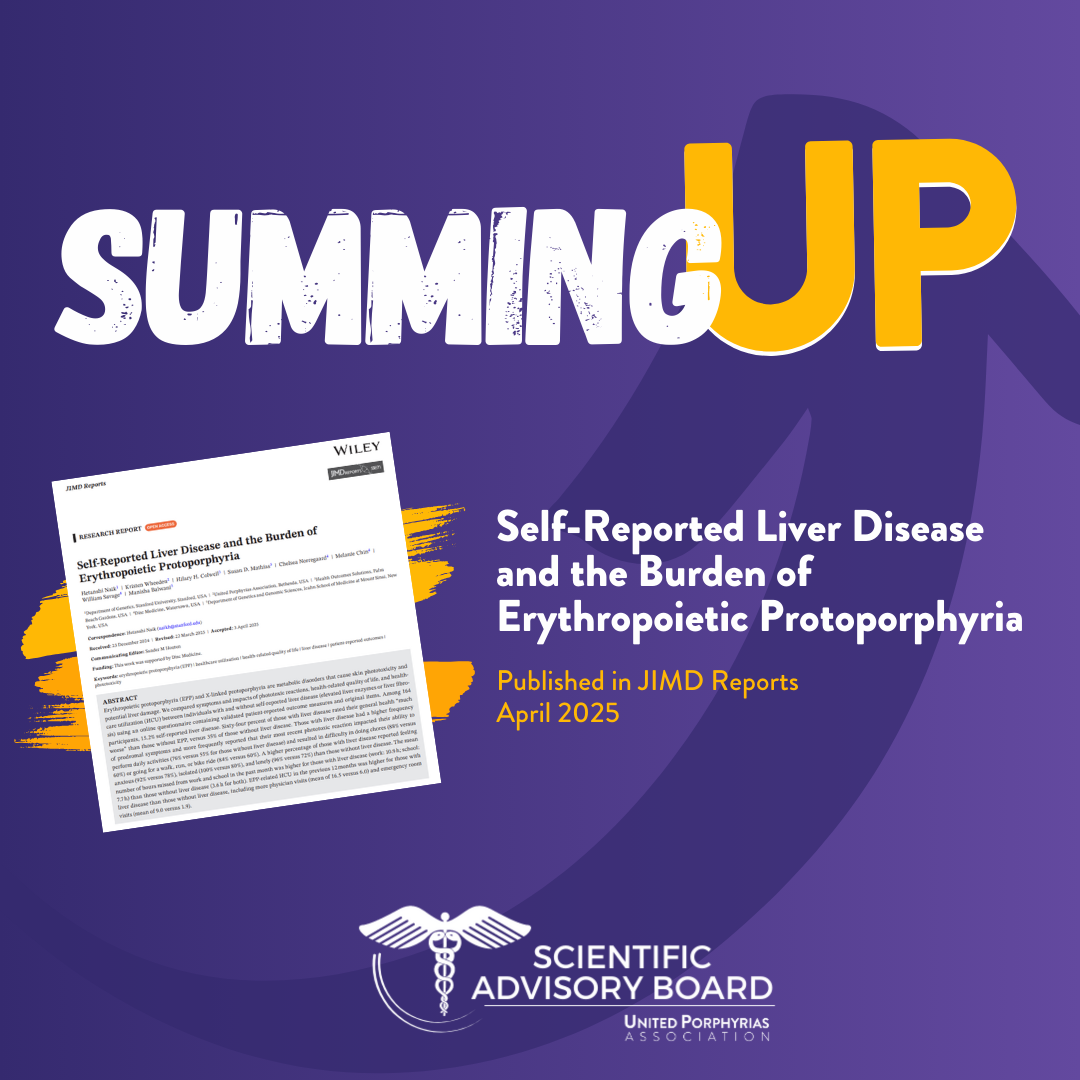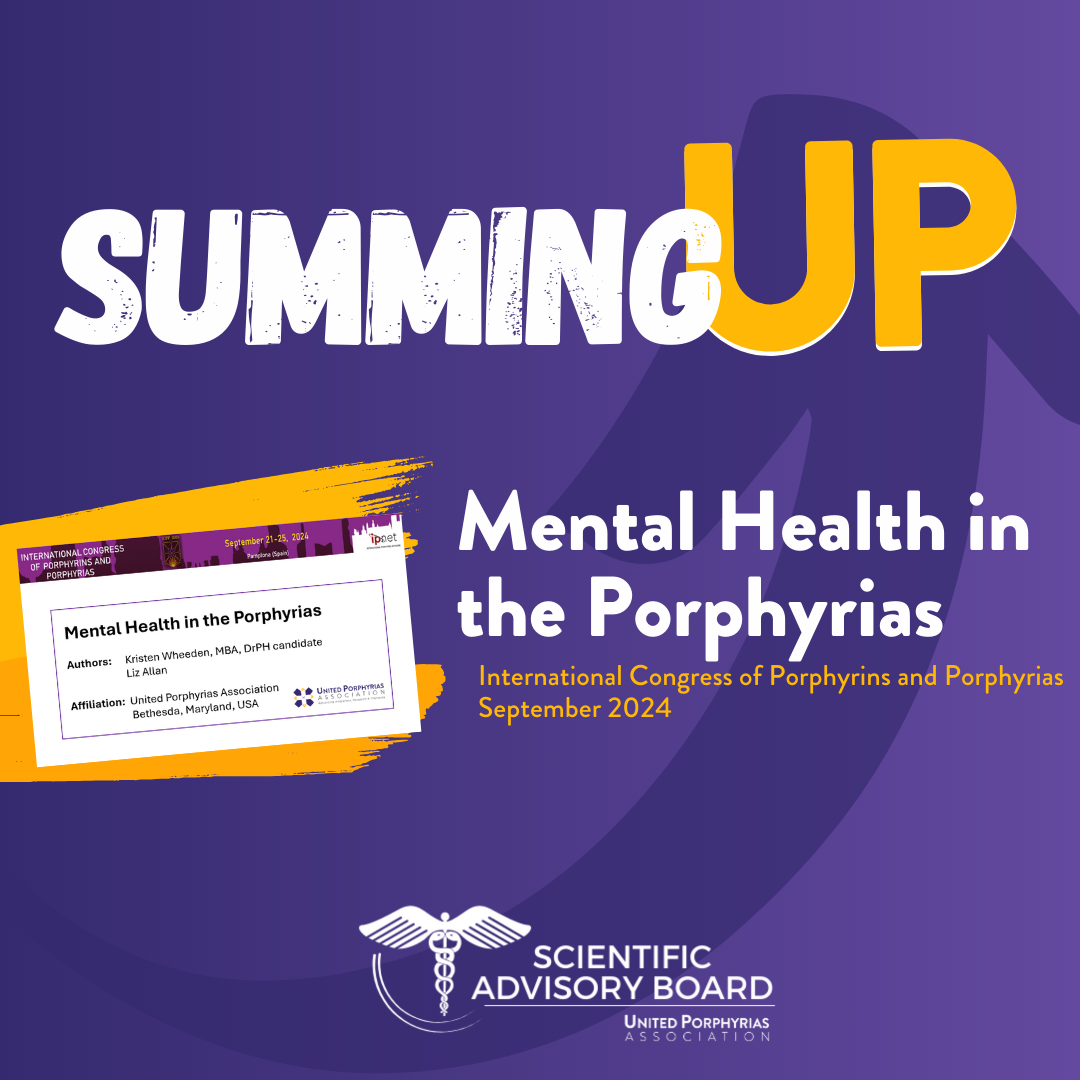The EPP Impact Questionnaire
Summing UP features the latest porphyria research in easy-to-understand summaries that have been reviewed and approved by the UPA's Scientific Advisory Board of porphyria experts.
Development and Content Validation of Novel Patient-Reported Outcome Measures to Assess Disease Severity and Change in Patients with Erythropoietic Protoporphyria: The EPP Impact Questionnaire (EPIQ)
Published February 2024 in Patient Related Outcome Measures, full article here.
Having a standardized questionnaire tool is important to evaluate and demonstrate the effectiveness and impact of new treatments for EPP. Regulators like the FDA consider improvements in quality of life, along with other factors, when deciding whether to approve new treatments.
This research developed a questionnaire to evaluate the impact of EPP on health-related quality of life (HRQL). The questionnaire is the EPP Impact Questionnaire or EPIQ. The topics and questions developed for the questionnaire were based on what EPP adult and adolescent patients identified as being important and relevant to them from interviews.
Read on to learn more about the EPIQ!
-
There are several questionnaires that have been used in past clinical trials for EPP (for afamelanotide and dersimelagon) but these questionnaires were not sensitive to changes that resulted from the treatment, because the questions were not always relevant to EPP. For example, standard questions for other skin conditions usually focus on visible symptoms. Visible symptoms are not very relevant to EPP compared to length of time in sunlight before symptoms and reduction of pain. This meant that, on paper, the treatments did not appear to have much of an impact.
One questionnaire has been developed for EPP (called the EPP-QoL [quality of life]); however, it was developed without patient input and doesn’t specifically address severe pain, sunlight avoidance or how sunlight avoidance impacts daily life. The EPP-QoL produces an “EPP symptom” score, but not a measurement for overall well-being. Therefore, a new tool is needed.
Additional measures have recently been proposed to evaluate the effect of a treatment in clinical trials for people with EPP, such as time-to-prodrome (early warning symptoms). This is useful to measure sun exposure and reduces the risk that the patient will have a severe phototoxic reaction in a trial, but it requires more study and is limited because it doesn’t consider pain severity.
-
Twenty-three EPP/XLP patients were recruited from the United States and Canada. There were 17 adults and 6 adolescents (ages 12 to 15). The group had an approximately equal number of male and female participants. They were mostly white (94%), and most adults had a college degree or higher (71%) and worked full time.
Participants were not eligible if they had been on afamelanotide for more than three months (because it was important they could remember their experiences before they started treatment). Of the 17 adults, 2 were taking afamelanotide during the study and 6 had previously taken afamelanotide.
A number of participants had EPP-related complications including liver disease (29%), anemia (24%), and gallstones (29%).
-
Researchers first interviewed 5 EPP patients and 5 porphyria experts using open-ended questions to identify concepts and issues that are important to EPP patients. Patients described concepts that were relevant to understanding their experience, including:
What it was like living with EPP
How long they could spend in direct sunlight each day
Describing symptoms, including frequency and severity, how the time of year and time of day impacted symptoms, type of light that would trigger symptoms, what the early warning symptoms were and location of the symptoms on the body
Impact of the symptoms on work
Social impacts of symptoms
Impacts of symptoms on physical functioning
Impact on outdoor activities
Based on the answers from these first interviews, a draft set of questions was developed.
Additional interviews were then conducted with the rest of the participants. These interviews asked patients to describe their experiences, to respond to the draft questions and to provide their feedback on the clarity and relevance of the questions. The additional interviews were done in waves, and between each wave the questions were adjusted based on feedback.
The questionnaire had three groups of questions:
The impact of EPP on ability to perform activities, overall HRQL, and comparing HRQL to those without EPP
The overall impression of severity of EPP (PGI-S)
The overall impression of change as a result of a treatment or study intervention (PGI-C).
Together, these capture the overall impact of EPP and a potential treatment. To help evaluate what change in one of these groups would be significant, patients were asked what level of change would be meaningful to them. For example, 42% said that it would be meaningful if their symptoms were at least “a little bit better” following treatment.
-
The interviews found that individuals with EPP experience a wide range of symptoms, and that there is a lot of variation between individuals. The most common symptoms reported were burning, pain, swelling, tingling, itching, sensitivity to touch, warmth/heat sensation, blisters, redness/discoloration, and sensitivity to hot/cold. Most patients reported that tingling/itching/burning sensations were the first symptoms to appear and would start before a full reaction. Pain was reported by most as the worst symptom of a full reaction.
Participants reported that EPP had a negative impact on their social and emotional well-being, ability to work, and to do daily activities.
The questions developed for the EPIQ were determined to be clear, understandable, and relevant to patients.
Conclusion
The EPIQ questionnaire has the potential to be a useful tool to measure changes in patients’ symptoms, reactions, and quality of life in future clinical trials.
CONTENT REVIEWED BY UNITED PORPHYRIAS ASSOCIATION SCIENTIFIC ADVISORY BOARD






